Servicios Personalizados
Revista
Articulo
Indicadores
-
 Citado por SciELO
Citado por SciELO -
 Accesos
Accesos
Links relacionados
-
 Citado por Google
Citado por Google -
 Similares en
SciELO
Similares en
SciELO -
 Similares en Google
Similares en Google
Compartir
Cuadernos de Geografía: Revista Colombiana de Geografía
versión impresa ISSN 0121-215Xversión On-line ISSN 2256-5442
Cuad. Geogr. Rev. Colomb. Geogr. vol.26 no.1 Bogotá ene./jun. 2017
https://doi.org/10.15446/rcdg.v26n1.52301
DOI: dx.doi.org/10.15446/rcdg.v26n1.52301
Federal University of Amazonas, Manaus – Brazil
* The results that support this article benefited from the following research grants: PRONNEX/FAPEAM–NEPECAB "Cidades Amazônicas: dinâmicas espaciais, rede urbana local e regional", "Soberania alimentar e rede urbana na Amazônia: um estudo do mercado de caça na tríplice fronteira Brasil–Peru–Colômbia" CNPq/Ciências Humanas 2013, 408231/2013–0. For the Peruvian field work grants from ird "SABA – Relation entre variabilité hydrologique et Sécurité Alimentaire dans le Bassin Amazonien: analyse à la frontière Brésil–Pérou"
** Associate Professor at the Federal University of Amazonas (UFAM) in the Geography Department, Manaus, Brazil. Researcher at the Center for Cities Studies in the Amazon (NEPECAB). Ruth Cardoso Chair Visiting Faculty at the Lemann Center for Brazilian Studies (2016–2017) at ILAS at Columbia University NYC with Fulbright/CAPES grant. CNPq Researcher.
Mailing Address: Av. Rodrigo Otávio Jordão 6200, Coroado, Manaus, Amazonas, Brazil. E–mail: tschor@ufam.edu.br
*** Economist. Researcher at the Center for Cities Studies in the Amazon (NEPECAB).
E–mail: thesco_iron@hotmail.com
RECEIVED: 4 AUGUST 2014. ACCEPTED: 31 MAY 2016.
Article of reflection seeks to analyze the Brazil–Peru–Colombia frontier in the state of Amazonas, Brazil, through the supply dynamics and market structure of chicken and eggs.
HOW TO CITE THIS ARTICLE: Schor, Tatiana, and Francisco Carlos da Costa Avelino. 2017. "Geography of Food and the Urban Network in the Tri–Border Brazil–Peru–Colombia: the Case of Production and Commercialization of Poultry in the Amazon." Cuadernos de Geografía: Revista Colombiana de Geografía 26 (1): 141–154. doi: 10.15446/rcdg.v26n1.52301.
Abstract
In the Brazilian Amazon, a strong transformation of eating habits has been identified. An important element of this transformation is the replacement of locally obtained protein by "frozen" chicken meat. This transformation of eating habits occurs differently depending on the market structure, production and commerce. We sought to analyze the Tri–Border region of Brazil–Colombia–Peru from the perspective of the production and trade ofchicken. We identified the importance of the city of Tabatinga and the particularities of the other cities, as well as urban interactions, supply flows and the economic relations that occur with the nearby Peruvian and Colombian cities. Using "chicken" as an important variable, this paper discusses the urban network and the frontier dynamics in the western border of the Amazon.
Keywords: Amazon, Brazil–Peru–Colombia, tri–border commerce, chicken market, urban network.
Resumen
En la Amazonía brasileña, se identifica cada vez más una fuerte transformación de los hábitos alimenticios, especialmente en relación con la sustitución del consumo de alimentos frescos por comida procesada. Un elemento importante de esta transformación es la sustitución de proteína obtenida a nivel local por la carne de pollo "congelado". Esta transformación de los hábitos alimenticios se produce de forma diferente dependiendo de la estructura de mercado, la producción y la comercialización. Hemos tratado de examinar el área de la Triple Frontera Brasil–Colombia–Perú, considerando la importancia de la ciudad de Tabatinga en la región y las peculiaridades de otras ciudades, así como las interacciones urbanas, buscando identificar los flujos de suministro y las relaciones económicas, que también se producen con las ciudades cercanas de Perú y Colombia. A través de la variable "pollo", este artículo hace una relectura de la red urbana y la dinámica en la frontera occidental de la Amazonía.
Palabras clave: Amazonía, Brasil–Perú– Colombia, comercio trifronterizo, hábitos alimenticios, red urbana.
Resumo
Na Amazônia brasileira, identifica–se cada vez mais uma forte transformação dos hábitos alimentares especialmente com relação à substituição do consumo de alimentos frescos pela comida processada. Um elemento importante dessa transformação é a substituição de proteína obtida localmente pela carne de frango "congelada". Essa transformação dos hábitos alimentares se produz de forma diferente e depende da estrutura de mercado, da produção e da comercialização. Tentou–se examinar a área da Tríplice Fronteira Brasil–Colômbia–Peru, a importância da cidade de Tabatinga na região e as peculiaridades de outras cidades, bem como as interações urbanas a fim de identificar os fluxos de abastecimento e as relações econômicas, que também são produzidas com as cidades próximas do Peru e da Colômbia. Por meio da variável "frango", este artigo faz uma releitura da rede urbana e da dinâmica na fronteira ocidental da Amazônia.
Palavras–chave: Amazônia, Brasil–Colômbia–Peru, comércio trifronteiriço, hábitos alimentares, mercado do frango, rede urbana.
Introduction
The change in eating habits by Brazilian consumers has accelerated in the last decade, leading the Instituto Brasileiro de Geografia e Estatística (IBGE) to incorporate nutritional matters in the Household Budget Survey of 2008–2009, building a nutritional composition table of the food consumed in Brazil. Launched in 2011, the survey indicates a significant increase in the consumption of carbohydrates, fats and salt by Brazilians. A significant increase was seen in processed food consumption. The transformation of the alimentary habits is unequal throughout the Brazilian territory. This diversification of food patterns in Brazil relates significantly to differences in access to food, eating and buying habits (Costa and Schor 2013; Moraes and Schor 2010). The Amazon within this scenario appears as an area of interest for the study of how the access to food implies the transformation of alimentary habits, especially in light of the growth of small and medium–sized cities. The state of Amazonas in the tri–border region is of great interest in this debate, since it enables a different understanding of the relationships that constitute the national border in the heart of the forest and the impact of Brazilian agribusiness in more remote places.
Moraes and Schor (2010) conducted a series of studies on the cost of living in cities located along the Solimões and Amazon rivers in order to understand the process of urbanization and the consequences on the Brazilian Amazon. An adaptation of the food staple of Departamento Intersindical de Estatística e Estudos Socioeconomicos (DIESSE) was performed adjusting the national staple to the eating habits within the Amazon. Price collection was performed during periods of flood and ebb of rivers. As a result a strong influence on the price of fresh produce was identified, which in turn influenced significantly the cost of the food staple. These results indicate the strong influence that the seasonality of rivers has on the average cost of living in the region and on eating habits.
The relationship that the hydrological system has on access to food proved strong from different outputs (Nardoto et al. 2011) not only regarding the price change of the products (Moraes and Schor 2010) but also regarding the changes in eating habits in the region (Costa and Schor 2013), especially the type of protein consumed. During high–water period scarcity of fresh food and the difficulty in obtaining proteins is a problem faced by residents of cities and Amazonian communities. The alternative found to overcome this obstacle is the replacement by industrialized products, such as canned foods, sausages, eggs produced in distant locations, and the industrialized "frozen"1 chicken.
The "frozen" chicken, after eggs, object of analysis of this study, is one of the most demanded products derived from the Brazilian agricultural industry. Both have a strong presence in the small and medium sized cities as direct replacement of several sources of protein, such as fish, beef and bushmeat (Moraes and Schor 2010; Nardoto et al. 2011; Schor et al. 2015).
The consumption of bushmeat in the tri–border is still intense (Van Vliet et al. 2015) but it is not fundamentally important in terms of food security but very important in terms of culture (Morsello et al. 2015) and important in terms of access to micro nutrients (Sarti et al. 2015). There has been an important transition in terms of protein from bushmeat to other forms such as poultry and beef.
This article seeks to analyze the Brazil–Peru–Colombia frontier in the state of Amazonas, through the supply dynamics and market structure of chicken and eggs. These variables were chosen due to the fact that preliminary studies (Costa and Schor 2013; Nardoto et al 2009; Schor and Costa 2013) showed the importance of these products in terms of food security in the region and the importance of poultry trade in the tri–border area.
As secondary data related to quantities of production and commercialization when available is feeble, interviews with local actors such as supermarket owners, transport (boat owners), technical personal related to agriculture extension and visits to local producers were chosen as methodological procedure. This methodology does not permit a quantitative perspective but allows a qualitative description of the commercialization and production of poultry in the study region. This study was conducted during two field works done in May and August 2014.
The Poultry Industry in Brazil
The 2015 and 2016 Annual Report of the Brazilian Association of Animal Protein (ABPA) showed some interesting figures related to the production, commercialization and consumption of chicken meat. There were no significant differences between both years. In terms of destination of chicken meat produced in 2014 and 2015, approximately 68% was for domestic market and 32% for exports. Brazil now exports chicken meat in a variety of forms to all continents. The Brazilian chicken meat production according to ABPA 2015 and 2016 annual report has increased from 5.98 million tons in 2000 to 12.69 million tons in 2014, maintaining the same value for 2015. Considering that the population has not grown at the same rate and that 68% of chicken meat produced is consumed domestically we can assume chicken meat has an increasingly important place at the Brazilian table.
In Brazil the consumption of chicken meat per capita (kg/person) has increased steadily in the last decade going from 29.91 kg/person in 2000 to approximately 43 kg/person in 2014/2015. The southern states are the main producers of chicken meat; in 2014 and 2015 they were responsible for approximately 63% of all meat produced – Paraná with 32.26%, Santa Catarina with 16.96% and Rio Grande do Sul with 14.24%. This data helps us understand the strength of the southern poultry industry and its impacts on the origin of poultry commercialization in distant regions such as the tri–border frontier Brazil–Colombia–Peru.
To understand the success of the Brazilian poultry industry and the consolidation of the country as a world exporter it is necessary to point out the historical factors that underlie the national poultry industry.
According to Belik (2007), , it is possible to identify a clear policy in agribusiness in Brazil between the 1960s and 1970s, based on the integration between the agriculture and processing industry. This policy was intended to encourage and add value to production for export, with the creation of the General Fund for Industry and Agriculture (FUNAGRI) in 1965, fundamental to the industrial growth.
During the 1970s, the chicken industry strengthened and modernized, relying on subsidized credit and agricultural policy with the installation of refrigerators. The strengthening of relations between domestic companies and foreign companies producing chicken processing factories also resulted in a strong step in the industry (Rizzi 1993). Animal handling techniques, genetic research, technical and meat conservation processes, control of animal production, management of training and industrial officials, among other factors, arising from the technological innovations of the Third Industrial Revolution, improved greatly in the meat industry (Espíndola 1999).
A clear example is the chicken growth capacity. In a range of approximate 60 years, between 1930 and 1996, this increased 65% with a 50% decrease in the amount of food consumed. Fattening time of 105 days in 1930 decreased drastically to 45 days in 1996, generating significant gains in the industry (Alves Filho and Araújo 1999).
According to Gordin (2003), the production chain starts with Avozeiros responsible for importing the lines and production of eggs until they are in Matrizeiras, producing matrices which will generate commercial chicks. Then the eggs are taken to hatcheries, already in the slaughterhouses or in integrative farms, until the birth of the animals and the subsequent transfer to rural poultry. The development and the process of fattening takes between 38 and 45 days; after this period the chickens are taken to slaughterhouses. The chicken industrialization process then starts, with the freezing of whole chicken or pieces that will generate the final product destined for domestic consumption and for export.
The Power of Differentiation in the Consumer Market
The budget set and the theory of preferences are essential for reaching the optimal consumer choice. According Varian (2006), consumers choose the most preferred basket of their budget set, that is, people choose the best things for which they can afford. To offer differentiated products is a trend characteristic of capitalist economies (Coutinho 1992). According to Rizzi (1993) product differentiation is a poultry competition trend.
Greater degree of product differentiation means breaking consumer adherence to certain brands, to the extent that via demonstration effect, a new product launched is a perfect replacement or even higher substitute (Rizzi 1993, 56).
Consumption of industrial chicken produced major changes in the eating habits of the Brazilian population. The regional free grown chicken was preferred by the consumer, but the more affordable price of the industrial chicken prevailed in the middle class and over time (Tavares and Ribeiro 2007, 81). However even with the high and increasing preference of consumption by the population of the industrialized / frozen chicken, regional chicken is recognized for its texture and distinctive flavor. As a preference, the agroindustrial brands Sadia and Perdigão started producing similar products and selling them frozen, looking for a differentiated product in the market. Some new brands have grown, such as Korin, which focuses on organic free–range chicken and eggs.
The Brazilian production of chicken meat in 2012 reached 12,645 million tons, an approximate reduction of 3% compared to 2011. In 2014 reached 12,69 million ton (UBABEF 2015) and 13,14 million tons in 2015 (ABPA 2016). Per capita consumption of chicken meat in Brazil in 2012 was 45 kg while beef had a per capita consumption of 39 kg, and pork 15 kg (ubabef 2013). This pattern has prevailed, in 2015 the consumption was of 43,25 kg per habitant (ABPA 2016). Chicken meat is the most consumed form of protein in Brazilian households.
In 2015 Brazil became the second producer of chicken in the world. The US maintains the first place producing 18 million tons, followed by Brazil with 13, 14 million tons, followed by China with 13,025. Brazil is first place in exports of poultry exporting 4,304 million tons followed by US with 2,990 million tons (ABPA 2016). An intensive production process is characteristic of industrialized chicken, with a better response in relation to time and the occupied area, justifying the policies to stimulate consumption (Fernandes, Paniago and de Lima 1989). In terms of global consumption, Brazil currently ranks fourth on a list headed by the us, followed by China and the European Union, but this is based on total population consumption. Consumption per capita in Brazil is approximately 2.5 times higher than the European and almost five times the Chinese consumption, with almost the same as the US (Avisite 2013).
According to the 2013 yearbook (UBABEF 2013), the industrialization and slaughtering of birds is concentrated entirely in the South and Southeast of Brazil, without significant participation of other regions, such as the State of Amazonas. This pattern has maintained itself throughout the years (ABPA 2016).
The Regional Chicken and its Production Chain
Having analyzed the consumer market for animal protein and its recent episodes of diseases that ravaged largely Europe and Asia, such as the cases of "mad cow" disease and avian flu, parallel alternatives in the market for consumers were opened such as protein sources free of hormones and harmful drugs to human health. The regional chicken re–appeared to meet much of this demand, as well as other types of organic foods (Crabone, Moori and Sato 2005).
Considered one of the most prominent alternative foods in Brazil (Loureiro 2012), the regional chicken has a different production process than industrial–frozen chicken. The process starts with the purchase of one day–old chicks, coming from farms matrices, with source lines themselves, designed specifically for the production system in question. According to Crabone, Moori and Sato (2005), the production process after purchase of day old chicks proceeds with the adaptation of the animals to the fattening farm, where they are confined for twenty–five days taking into account the proper care, especially temperature; improper temperature is the greatest cause mortality of birds in the early days and even in adulthood. After the period of confinement of birds, free access is permitted to the outside area of the sheds (picket). The chicks are released and are free to feed naturally returning by night to the sheds.
The commercialization of regional chicken is usually done by small family farmers or micro entrepreneurs. Due to the small scale of production, the sale is performed either in their own homes, door to door, or at fairs and markets with the permission of legal health authorities (Crabone, Moori and Sato 2005).
These are overall views of how the production, commercialization and consumption of poultry happens in Brazil, but the reality in other regions, especially distant regions such as the Brazilian Amazon, is quite different. There is no data available for Amazonas in terms of production and commercialization. In the 2015 ABPA Report Amazonas State appears shrouded in gray with no available data. This lack of available data implies that field work and primary data collection are very important in the regional context.
Poultry in Amazonas State and in the Tri–border Brazil–Peru–Colombia
The state of Amazonas currently has a very small share of poultry production in Brazil. The poultry industry in the Amazon is mainly concentrated in the metropolitan region of Manaus. Table 1 presents the most recent results from Amazonas State Statistical Yearbook, 2012 (SEPLAN 2013), which shows official figures of the poultry population and egg production for the years 2010, 2011 and 2012.
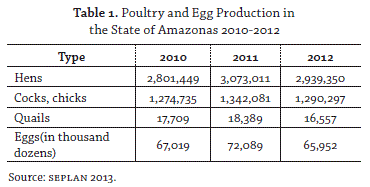
Egg production in Amazonas partially meets the demand of the main consumer market, the capital Manaus, with almost two million inhabitants (IBGE 2015), and nearby municipalities, increasing the degree of importance of this activity. For other regions, such as the Upper Solimões, especially the cities where the research was carried out, the egg production and poultry supply coming from Manaus is not significant in economic terms, due to transport costs, (more than 1000 km –six days by regional transport), and losses attributed to the distance between cities. Distance and transport cost justify local production of eggs and also importing from Peruvian nearby towns. The official production of eggs in the cities of Tabatinga, Benjamin Constant and Atalaia do Norte are shown in table 2.
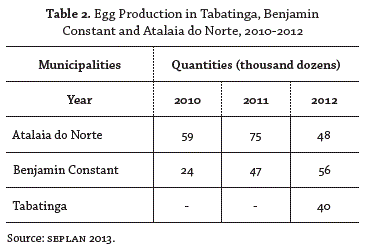
It can be observed in table 2 that official egg production in the region is insufficient considering the 200,000 people living in cities in the tri–border.
For the production of industrialized chicken in the state of Amazonas, industry impairment leads to the need to seek supply from the main producing areas of the country, in this case the South and Southeast. The capital Manaus, a metropolitan region, with more than two million inhabitants, a great potential consumer market, large retail chains and wholesalers established is a central nodule in poultry commercialization. Manaus has an important role as a warehouse for supply of poultry and eggs to cities in the hinterlands of the state. In the Upper Solimões River, the cities studied have a strong commercial link with Manaus. The main supermarkets or wholesalers buy from Manaus sales representatives for the industrialized–frozen chicken which is then sold locally. Given the lack of land connection between Manaus and cities in the Upper Solimões River and the fact that air cargo transport is not attractive in terms of costs, the only solution for the chicken and egg supply is river transport.
The use of mixed regional passenger and cargo vessels, fitted with internal refrigerators for the conservation of the product, is the form found by regional commerce to transport from Manaus to the cities, on a trip of at least one week in duration up the Solimões River. It is noteworthy that many of these vessels, even with refrigerators, do not perform the proper storage, resulting in losses for traders. In total, between the major supermarkets and wholesalers of cities, eight establishments were interviewed; three in Tabatinga, three in Benjamin Constant, and two in Atalaia do Norte. All of them complained about losses of merchandises due to improper transportation.
The existence of regional production of hens and chickens in the cities of Tabatinga, Benjamin Constant and Atalaia do Norte, according to official data (table 3) leads to assume that the local production functions as complementary to consumption of industrialized chicken coming from Manaus. Six producers were visited and interviewed, two in each city, to verify on–site production, understand and describe the entire production chain and the existing commercial dynamics in the region, mainly in order to understand how the commercialization is carried out.
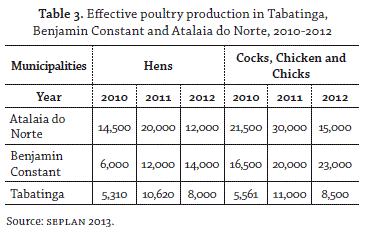
The micro–region of Upper Solimões on the triple border Brazil–Peru–Colombia, location of the cities in focus (figure 1), has a strong commercial link with cities in neighboring countries. Intense trade and the flow of people between Tabatinga and Leticia in Colombia, Santa Rosa in Peru along with other Peruvian and Colombian nearby cities is an important aspect of the region. The same with Benjamin Constant and Islandia, Peru (Souza 2014) and in Atalaia do Norte and Nazareth (Peru). Besides these, the city of Caballococha in Peru makes up the triple border urban network. The population of the three Brazilian cities counts for more than 113,000 people according to the IBGE census for 2013 (table 4).
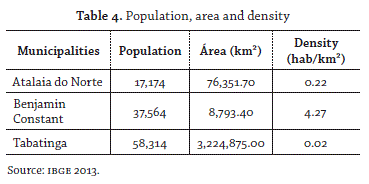
With field activities in the region on at least two occasions, both in the dry season and high water of the Solimões River, it was possible to empirically establish the reality of the local dynamics and how they interact with the economic agents. The strong presence of the chicken culture in cities is evident, more explicitly in Tabatinga and Leticia, with a large presence of restaurants specializing in chicken, known as assadeiros. The chicken or the pollo as it is called in Spanish is preferred by consumers, resulting in a clear explanation by a Brazilian trader in Tabatinga:
- [...] every Monday is the same, this is the best day to buy chicken, they (the Israelis) bring poultry and the people already know, these people are very fond of chicken, eat chicken all the time, if you come up here and look for the restaurants they sell chicken soup even for breakfast. (Vendor A., May 19, 2014)
To better understand the statement described by the vendor A, the region has a supply of animals, fruits and vegetables carried out by members of the Evangelical Association of the Israelis for the New Universal Pact Mission (AEMINPU), from Peru. Known locally as "Israelites", they are important producers of vegetables, fruits and animals that supply the tri–border cities. "Israelites" products come from the communities located in the Brazil–Peru border, especially along the Javari river, down to the tri–border cities, where they are sold in the port, or in the area known as "edge"2 by local residents.
Monday, according to the account of the vendor A, is the day that the Israelites sell their products in Tabatinga. Commercialization (figure 2) starts early in the morning, until the products are totally sold. The commercialization of poultry, live chickens and roosters, enabled us to collect weight and price samples, which resulted in an average amount charged per kilo of birds. This procedure was necessary because live poultry is normally sold in units, that is, each bird has a stipulated price, which will vary according to the size and body characteristics. The price is made "by the eye", as stated by the sellers.
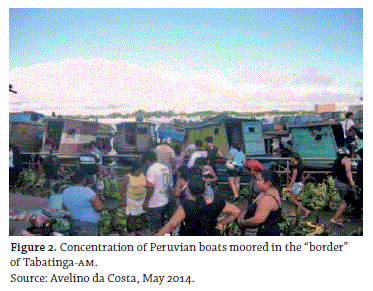
Demand for animals such as free–range chickens and regional chickens is large in the Tabatinga "border" market. The same happens in the Municipal Market, which enabled us to identify a preference for this type of product, characterized by the consumers themselves as a differentiated product, tastier and healthier compared to industrialized–frozen chicken. A number of factors directly influenced the choice. The survey enabled us to identify some of them; the most significant is price and product availability in relation to the industrializedfrozen chicken.
The reports made locally about the sale of regional chickens and hens allowed a comprehension of what factors influence the choice. The price, as in all markets, can be taken as one of the most prevalent, as the following dialog demonstrates, being transcribed from data collection held in the Municipal Market of Tabatinga, in the internal market stalls that sell regional chicken, also known as chicken from farms or 45 days poultry.
"How much is the price of the chicken? Client A asking about the price of 45 day poultry [...] 18 reales [...]". (Vendor A). "Frozen is cheaper" (Client A referring to the price of frozen chicken).
Data collection held in the three cities permitted an estimate of the average price per kilogram of poultry products, whether industrialized–frozen chicken sold in the most diverse and varied brands in supermarkets and grocery stores in the cities, or the regional poultry or free–range chickens (table 5).
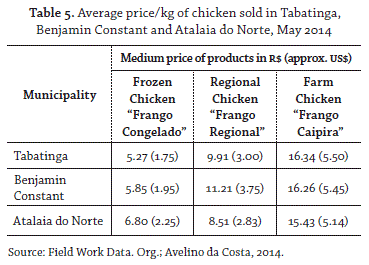
It was important to collect this primary data due to the nonexistence of such data officially. Prices can give us an interesting parameter in terms of comparison of the different types of poultry commercialized in the region, which can be seen in table 5.
Production and Commercialization of Regional Chicken in the Tri–border
The regional chicken, as already mentioned, is known locally as farm chicken, slaughter chicken, white chicken or 45 days. This product has a simple supply chain, allowing some traders to invest in the activity. The production chain begins with the purchase of one dayold chicks, as they are known. Producers of Tabatinga, Benjamin Constant and Atalaia do Norte, as reported, do not purchase from Manaus, due to expensive freight that does not offset the investment because transport to the Alto Solimões is performed only by boats and ferries, which directly influences the high mortality of birds. The purchase is made from Colombian poultry suppliers (shops specializing in equipment and supplies for farms) of the city of Leticia, which brings the animals by air from farms incubators from Bogota. This information is very valuable due to the fact that it is hidden in official statistics of both countries and indicates an important commercial flow between them not recognized by public authorities. Table 6 shows the average cost of one day–old chicks for producers of every town:
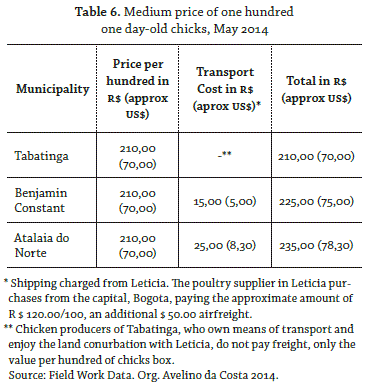
From the purchase of one day–old chicks, the chicks are then confined in farms throughout the growing process and fattened, vaccinated and fed with food from Manaus; this also influences differential cost to producers of each city, as table 7 shows:
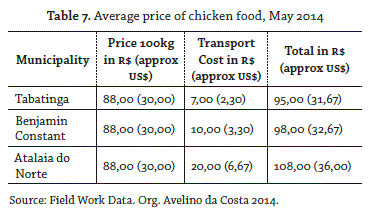
According to local producers, for every hundred chicks at least twelve food sacks of various types are consumed on average, in a process that lasts forty–five days; at the end of that period the bird is ready to be harvested and sold to the consumer. According to information obtained from producers if there is no demand for the birds, these are fed with wheat bran (farelo de trigo) until there is a demand and the slaughtering is performed. Wheat bran according to the producers ensures that the bird food will result in a flavor similar to the purely free–range chicken (figure 3).
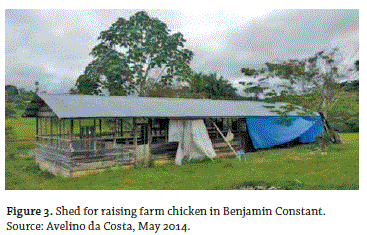
The sale of farm chicken is usually done in the markets stalls and markets; there are few facilities outside markets that commercialize this product. Many of the producers outsource to people who sell the chicken in the markets, leaving the seller with only R$ 1.50 (usd 0.50C, 2014) per chicken sold; the amount paid to thirdparty seller (each chicken sold) is the same in the three cities visited. One of the vendors, during a casual conversation, gave the following account of his monetary gain by selling chicken:
- [...] I sell the chickens here, gain 1 with 50 [R $ 1.50/ USD 0,50C] per chicken which is just right, I make my money, with the money I make, I withdraw and buy few pounds of bush meat I buy at eight [R $ 8.00 / kg / USD 2,50/kg] and sell for ten [R $ 10.00 / kg – USD 3,10/kg], I hide them here in the thermic box, the customer comes to buy a chicken and carries a paca, a monkey, these days I sold a five pounds, one jaguar in my pocket (image on the R$ 50.00 note), then the Deputy Chief comes pisses me off because I am selling animal of the forest, the same guy that buys my bush meats confiscates my thermic box [...].(Vendor B)
The report enriches the understanding of the market demonstrating the ability of chicken seller in interacting with the space around him, not limited only to selling chicken but also acting as illegal bush meat vendor. In this region there is a strong and illegal trade in bush meat that is strongly tied to local food culture and the spectrum of access to animal protein, ranging from the "frozen" chicken from the producing states of Santa Catarina and Paraná, to the consumption of fish raised in captivity, fish from the river, turtles and their eggs and finally the bush meat of different species (Tavares–Pinto 2015).
Backyard Hens: Productive Process and Commercialization
Another product that acts as possible substitute for the industrialized / frozen chicken and has an attractive distinctive flavor and is a healthier product according to consumers is the backyard raised hens. In both places visited, we could identify the "borders" of cities and farms in the commercialization of free range chickens, backyard hens and roosters for fighting. As previously reported, the sale of chickens and roosters by the "Israelites" (figure 4) is very dynamic, and involves ordinary consumers seeking a chicken with the best price and also middlemen who buy chicken to resell earning at least R $ 5.00 Reales per unit.
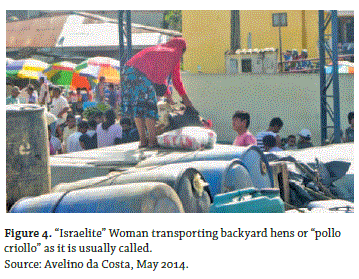
The production of free–range chickens is not exclusive to the Peruvian "Israelites"; this production exists in the tri–border cities. Some of these areas were visited and it was possible to discover and describe the production chain, which operates in a more simplified way than the production chain of farm chicken, described above.
In the cities studied, there are few chicken farmers that produce and commercialize in an organized format. Producers visited work with regional chicken production parallel to the laying hens, and initially the creation of free–range chickens is focused on the family's own supply, then the production surplus is sold to neighbors or relatives. Many have found this activity an opportunity to achieve economic success, so investing resources in adapting their backyards into areas aimed at creating free–range chickens such as fencing and building chicken coops in an amateur way is usually the procedure. The commercialization can happen at the producer homefarm or in more established places such as the local market and fairs (figure 5).
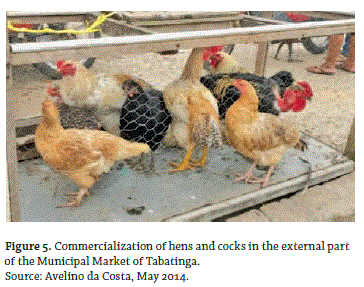
Eggs: Production and Commercialization
The commercialization of eggs in the tri–border region presents several alternatives for the supply, whether from Brazilian local producers or by Peru and Colombia. The production of laying hens, also known as botadeiras in the region, are common in cities, where it was possible to visit some of them during field activities.
Supermarkets and grocery stores in the area are important buyers of eggs from local producers. This situation changes when there is a high demand which local production is unable to meet; then the supermarkets owners buy eggs from Peruvian and Colombian producers, and more commonly import eggs from Iquitos in Peru.
Forecast production for the month of May 2014 regarding the production of eggs in the city of Benjamin Constant, which according to official SEPLAN–AM data has the most significant egg production in the region, was estimated at 69,840 eggs, with a daily average of 2,328 eggs.
Egg production in the cities follows a cycle in which laying hens have an average life span of just over a year, and at the end of their life, with low productivity, are sold for consumption.
Frozen Chicken: Fluxes, Distribution and Market Characteristics
Looking at the tri–border from the chicken trade, the existence of a strong market for industrialized–frozen chicken stimulates analysis as to why chicken is a strong alimentary habit in the region.
Cultural and economic factors are strong candidates to trace a market profile. The influence of the Colombian and Peruvian cultures and the strong appreciation for the pollo are striking features both in the city of Leticia as in Tabatinga. The publicity surrounding chicken by restaurants and establishments specializing in roasted chicken and derivatives as well as supermarkets and grocery stores is impressive. Industrialized–frozen chicken is easily found, compared to the regional chicken and the free–range chicken, and which according to one of the chicken sellers in the Municipal Market Tabatinga is influenced by price and easy access: "any grocery store or small market sells frozen chicken" (Chicken Vendor B).
The availability of industrialized–frozen chicken then becomes a variable to be considered to form, along with the most affordable price, a product with a strong output in supplying establishments. Data collected in major supermarkets and wholesalers in Tabatinga showed the amount of frozen chicken sold in the months of February, March and April 2014.
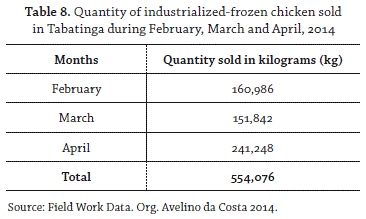
Note that the flow of supplies from the cities studied has differences. Tabatinga is responsible for supply through the wholesale trade of industrialized–frozen chicken to several cities nearby, including Benjamin Constant, in which supermarkets buy from wholesalers of Tabatinga. The Brazilian industrialized–frozen chicken penetrates Peru from Tabatinga, reaching the city of San Pablo de Loreto, in the department of Loreto, and Colombia, reaching the city of Puerto Asís, in Putumayo department.
Colombian supermarkets visited, especially in the city of Leticia, sell the Brazilian industrialized–frozen chicken, alongside the sale of Colombian chicken (figure 6), but with a clear distinction between products. The Brazilian industrialized–frozen chicken, despite being cheaper, is taxed as an unhealthy product, containing hormones that affect health, contrary to Colombian chicken, which is sold by traders as a free range product free of hormones and medications, but with a higher price, which in fact leads to strong demand for Brazilian chicken.
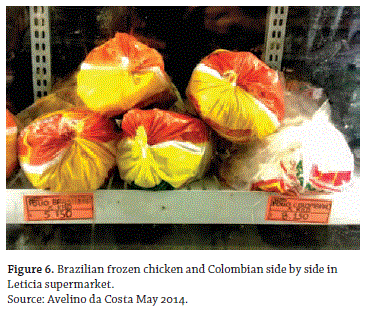
The demand for Brazilian industrialized–frozen chicken also comes from Peruvians, including Israelites, arriving at Tabatinga especially to buy industrialized–frozen chicken and take to the distant communities. It is worth noting that as already discussed, the Israelites are important traders of livestock in Brazilian cities, and in turn consume the Brazilian industrialized–frozen chicken, buying in bulk chicken boxes that are transported in boats to the Israeli communities.
In field work conducted in September 2014 the markets of the Peruvian cities of Iquitos, Nauta, Indiana, Mazan, Pebas, San Pablo de Loreto and Caballococha, we identified the importance of chicken in food and food security in the Peruvian Amazon. Unlike the Brazilian side the Peruvian Amazon produces poultry and sells them alive. There is almost no "frozen" chicken of any brand or origin; there is a preference for fresh produce that significantly modifies the form of chicken marketing when compared to the Brazilian Amazon.
The Agrarian Agency of Iquitos, Peru, informed us that there are three large poultry production companies: Don Pollo (multinational) with 18 farms / approximately 750,000 birds; Los Hermanos Gran Monasi with six farms / 220,000 about birds and the Nitaia with eight farms and approximately 130,000 birds. All three companies have farms incubators. In the region of Loreto, Peruvian Amazon has 32 farms in Ucayali, 10 farms in Requenas and 70 in Iquitos. Iquitos is self–sufficient in poultry, unlike the Brazilian Amazon that depends on the southern state of Paraná for the supply of industrialized– frozen chickens. However Iquitos is not selfsufficient in the production of eggs and corn; the vast majority comes from San Martín.
We found the "frozen" chicken from the Brazilian agribusiness in Peru in the city of San Pablo de Loreto and a strong market in Caballococha, Santa Rosa, Islandia, closer to the tri–border cities.
Conclusions
The inexistent official statistics related to local production, commercialization and consumption of chicken meat and eggs does not mean that this is an unimportant market structure. Through field work observations, interviews and primary data collection a different scenario is constructed where the poultry network appears as an intense tri–border activity linking the three countries in strong tries.
The comparative analysis of the production process and the marketing network of poultry between the three countries shows how differences in eating habits, national agribusiness and poultry marketing network allow analysis of the triple frontier differently, which goes beyond the traditional guided discussions on geopolitics and illegal markets.
The analysis of the poultry market in the Amazonian tri–border Brazil–Colombia–Peru allows an understanding not only the intense flows of products and people in the region but also the impact of the agribusiness in the Brazilian territory. The transformation of the forest into mono–cultures of corn and soy beans that become cheap food for poultry industry in the south has not only a direct impact on deforestation but also in the changing of alimentary habits which is a more subtle and intense way of transforming the forest. The dependence on cheap protein has an impact on food security and sovereignty in the region.
Notes
1 We use the term "frozen" in quotes because in river transport process the chicken coming from the south of the country freezes and thaws and is often sold thawed in basins.
2 The "edge" is the space between the dock and the river. In the period of ebb of the Solimões River floodplain an entire stretch in front of the municipal dock of the three cities analyzed become a large area of the market, with products from family farming exposed on the ground (Schor et al. 2015).
References
ABPA (Associação Brasileira de Proteína Aninal). 2015. Relatório Anual 2015. Brasil: ABPA. [ Links ]
ABPA. 2016. Relatório Anual 2016. Brasil: ABPA. [ Links ]
Alves Filho, Eloy, and Maria da Piedade Araújo. 1999. "Origens e desenvolvimento do sistema de produção integrada no Brasil." In Agronegócio e desenvolvimento regional, coordinated by Francisco Casimiro Filho and Pery Francisco Assis Shikida, 117-152. Cascavel: Edunioeste. [ Links ]
AviSite. 2013. Produção Animal - Avicultura 79 (07) december. http://www.flip3d.com.br/web/pub/avisite/index2/?numero=79. [ Links ]
Belik, Walter. 2007. "Agroindústria e política agroindustrial no Brasil." In Dimensões do agronegócio brasileiro: políticas, instituições e perspectivas, organized by Pedro Ramos, 141-170. Brasília: Ministério do Desenvolvimento Agrário (MDA). [ Links ]
Costa, Ellen Anjos Camilo da, and Tatiana Schor. 2013. "Redes urbanas, abastecimento e o café da manhã de idosas na cidade de Tefé, Amazonas: elementos para a análise da Geografia da Alimentação no Brasil." Hygeia: Revista Brasileira de Geografia Médica e da Saúde 9 (17): 52-73. [ Links ]
Coutinho. Luciano. 1992. "A terceira revolução industrial e tecnológica: As grandes tendências de mudanças." Economia e Sociedade 1:69-87. [ Links ]
Crabone, Gleriani Torres, Roberto Giro Moori, and Geni Satiko Sato. 2005. "Fatores relevantes na decisão de compra de frango caipira e seu impacto na cadeia produtiva." Organizações Rurais & Agroindustriais, Lavras 7 (3): 312-323. [ Links ]
Espíndola, Carlos José. 1999. As agroindústrias no Brasil: o caso Sadia. Chapecó: Grifos. [ Links ]
Garcia Fernandes, Sérgio, Euter Paniago, and João Eustáquio de Lima. 1989. "Análise de alternativas relacionadas com a demanda e a oferta de carnes no Brasil." Revista de Economia e Sociologia Rural 27 (4): 437-461. [ Links ]
Gordin, Mara Huebra de Oliveira. 2003. "Cadeia produtiva da carne de frango em Mato Grosso do Sul: instrumento para desenvolvimento local." Master's Thesis in Local Development, Universidade Católica Dom Bosco, Campo Grande. [ Links ]
Loureiro, João Paulo Borges de. 2012. "Estudo do mercado consumidor e da viabilidade econômica da produção de frangos caipira no município de Parauapebas." Master's Thesis in Saúde e Produção Animal na Amazônia, Universidade Federal Rural da Amazônia, Brasil. [ Links ]
Ministerio de Saúde, IBGE (Instituto Brasileiro de Geografia e Estatística), and Ministério do Planejamento, Orçamento e Gestão. 2010. Pesquisa de Orçamentos familiares 2008-2009: Antropometria e estado nutricional de crianças, adolescentes e adultos no Brasil. Rio de Janeiro: Ministerio de Saúde, IBGE and Ministério do Planejamento, Orçamento e Gestão. [ Links ]
Moraes, Andre de Oliveira, and Tatiana Schor. 2010. "Redes, rios e a cesta básica regionalizada no Amazonas, Brasil." Acta Geográfica 4 (7): 79-89. [ Links ]
Morsello, Carla, Blanca Yagüe, Letícia Beltreschi, Nathalie Van Vliet, Cristina Adams, Tatiana Schor, Maria Paula Quiceno-Mesa, and Daniel Cruz. 2015. "Cultural Attitudes are Stronger Predictors of Bushmeat Consumption and Preference than Economic Factors Among Urban Amazonians from Brazil and Colombia." Ecology and Society 20 (4): 21. doi: 10.5751/ES-07771-200421. [ Links ]
Nardoto, Gabriela B., Rui Sergio S. Murrieta, Luis Enrique G. Prates, Cristina Adams, Maria Elisa P. E. Garavello, Tatiana Schor, Andre se Moraes, Fernando D. Rinaldi, Juliana G. Gragnani, Edila A. F. Moura, Paulo J. Duarte-Neto, and Luiz A. Martinelli. 2011. "Frozen Chicken for Wild Fish: Nutritional Transition in the Brazilian Amazon Region Determined by Carbon and Nitrogen Stable Isotope Ratios in Fingernails." American Journal of Human Biology 23 (5): 642-650. doi: 10.1002/ajhb.21192. [ Links ]
Rizzi, Aldair Tarcisio. 1993. "Mudanças Tecnológicas e Reestruturação da Indústria Agroalimentar: o caso da indústria de frangos no Brasil." Doctor's Thesis in Economy, Universidade Estadual de Campinas, Campinas. [ Links ]
Sarti, Flavia M., Cristina Adams, Carla Morsello, Nathalie Van Vliet, Tatiana Schor, Blanca Yagüe, Leady Tellez, Maria Paula Quiceno-Mesa, and Daniel Cruz. 2015. "Beyond Protein Intake: Bushmeat as Source of Micronutrients in the Amazon." Ecology and Society 20 (4): 22. doi: 10.5751/ES-07934-200422. [ Links ]
Schor, Tatiana, Moisés Augusto Tavares-Pinto, Francisco Carlos da Costa Avelino, and Marina Lelis Ribeiro. 2015. "Do peixe com farinha à macarronada com frango: uma analise das transformações na rede urbana no Alto Solimões pela perspectiva dos padrões alimentares." Confins 24. Accessed 21th July 2015. https://confins.revues.org/10254?lang=pt. [ Links ]
SEPLAN (Secretaria de Estado de Planejamento e Desenvolvimento Econômico). 2013. Anuário Estatístico do Amazonas 2012. Manaus: SEPLAN. [ Links ]
Souza, Alex Sandro Nascimento de. 2014. "A cidade na fronteira: Expansão do comércio peruano em Benjamin Constant no Amazonas - Brasil." Master's Thesis in Geography, Universidade Federal do Amazonas, Manaus. [ Links ]
Tavares, Luciano de Paulo, and Kárem Cristina de Sousa Ribeiro. 2007. "Desenvolvimento avicultura de corte brasileira e perspectivas frente à influenza aviária." Organizações Rurais e Agroindustriais, Lavras 9 (1): 79-88. [ Links ]
Tavares-Pinto, Moises Augusto. 2015. "A caça e a pesca na beira de Tabatinga: um estudo do mercado de recursos naturais na tríplice fronteira Brasil-Colômbia-Peru." Master's Thesis in Ciências do Ambiente e Sustentabilidade na Amazônia, Universidade Federal do Amazonas, Manaus. [ Links ]
UBABEF (União Brasileira de Avicultura). 2013. Relatório Anual 2013. Brasil: UBABEF. [ Links ]
Varian. Hal R. 2006. Microeconomia princípios básicos: uma abordagem moderna. 7ed. Rio de Janeiro: Elsevier. [ Links ]
Van Vliet, Nathalie, Maria Paula Quiceno, Daniel Cruz, Lindon Jonhson Neves de Aquino, Blanca Yagüe, Tatiana Schor, Sara Hernandez, and Robert Nasi. 2015. "Bushmeat Networks Link the Forest to Urban Areas in the Trifrontier Region Between Brazil, Colombia, and Peru." Ecology and Society 20 (3): 21. doi: 10.5751/ES-07782-200321. [ Links ]
Recommended Reading
ABIPECS (Associação Brasileira da Indústria Produtora e Exportadora de Carne Suína). 2013. Relatório Anual 2012-2013. Brasil: ABIPECS. [ Links ]
Corrêa, Roberto Lobato. 1987. Região e organização espacial. 2ed. São Paulo: Ática. [ Links ]
Espíndola, Carlos José. 2009. "A cadeia produtiva de frango de corte na América do Sul: considerações preliminares." Paper presented at the XII EGAL "Caminando en una América Latina en transformación", Universidad de la República, Montevideo, 3th-7th april. [ Links ]
Marinho, Thiago Pimentel, and Tatiana Schor. 2012. "Nos interflúvios do rural e do urbano na Amazônia: o caso de Codajás-Amazonas, Brasil." Acta Geográfica 6 (11): 69-81. doi: 10.5654/acta.v6i11.466. [ Links ]
Moraes, André de Oliveira, and Tatiana Schor. 2011. "As Redes Urbanas na Amazônia: a cidade como o começo e o fim." Revista de Geografia de América Central 2 (47 E); 1-15. [ Links ]














